
I don't think any two actors appearing together, in a series of motion pictures, has had the impact World Wide of Peter Cushing and Christopher Lee. This is a look at the motion pictures this team did for "The House of Hammer".
Prior to their teaming up Cushing had the longer career. He started as the "Second Officer", with on screen credit, in the June 26, 1939 American version of Alexander Dumas' "The Man in the Iron Mask". The feature starred Louis Hayward and Joan Bennett and was Directed by James Whale.
While Christopher Lee first appeared on the BBC variety program "Kaleidoscope", December 20, 1946, in the section which showcased the "Rank Organizations" new actors and actresses.
Their first appearance together, but not necessary in the same scenes was in Sir Lawrence Olivier's September 29, 1948 motion picture version of William Shakespeare's "Hamlet" co-starring Jean Simmons.

Above Lawrence Olivier as "Hamlet", Peter Cushing as "Osric" and Terence Morgan "Laertes". Below is a blurry picture of Christopher Lee as a "Palace Guard".
.jpg)
The two would cross paths again 8 years later in March 26, 1956's "Alexander the Great" starring Richard Burton, Fredrick March and Claire Bloom. Peter Cushing would be seen as "General Memnon" and Christopher Lee would dub the on screen voice of "Nectenabus". Who was played by German speaking actor Helmut Dantine.
Then one year later I was on my house's roof.
THE CURSE OF FRANKENSTEIN released June 25, 1957
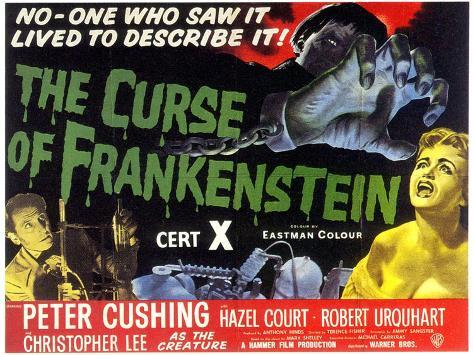
This was the first Hammer Film's reboot of the Universal Pictures Classic Monsters. Filmed in "Eastman Color", or as they say in the U.K. "Eastman Colour" with beautiful bloody gore.
The screenplay was by the great Jimmy Sangster, One of my favorite Science Fiction movies was his 1956 "X-The Unknown", in 1958 he wrote "Dracula" aka: "Horror of Dracula", "The Revenge of Frankenstein", "Blood of the Vampire" and "The Trollenberg Terror" aka: "The Crawling Eye" and in 1959 his screenplays were "Jack the Ripper", "The Mummy" and "The Man Who Could Cheat Death".
The motion picture was directed by Terence Fisher, Besides "The Curse of Frankenstein" Fisher directed 1958's "Dracula" and "The Revenge of Frankenstein", in 1959 his work included "The Hound of the Baskervilles", "The Man Who Could Cheat Death" and "The Mummy", 1960 saw Terence Fisher directing "The Brides of Dracula", "The Two Faces of Dr. Jekyll" aka: "House of Fear, Hammer studios had him direct in 1961 "The Curse of the Werewolf" and "The Phantom of the Opera".
Neither Hammer Studios, or first billed Peter Cushing had any idea of what "The Curse of Frankenstein" would lead too. For that matter neither did fourth billed Christopher Lee as "The Creature". This role became career creating for Lee and comparable to the basically unknown Boris Karloff as "The Monster" in 1931.
Peter Cushing was the adult "Victor Frankenstein".
Hazel Court was "Elizabeth". She co-starred in the 1954 U.K. Science Fiction film "Devil Girl from Mars" and was in three of Roger Corman's Edgar Allan Poe series: 1962's "Premature Burial", 1963's "The Raven" and 1964's "The Masque of the Red Death". My article 'HAZEL COURT: Frankenstein's Bride and Rodger Corman's Evil Lady" can be read at:
http://www.bewaretheblog.com/2017/06/hazel-court-frankensteins-bride-and.html

Robert Urquhart was "Paul Krempe". Urquhart had appeared mostly on British television since 1950. Some of his film work included "Sir Gwain" in the big budgeted 1953 "Knights of the Round Table" starring Robert Taylor, Ava Gardner and Mel Ferrer. In 1955 Robert Urquhart was "Sir Phillip" in "The Warriors" starring Errol Flynn and Joanne Dru. In 1963 the actor portrayed one of the British delegation in "55 Days at Peking" starring Charlton Heston, David Niven and Ava Gardner.

Christopher Lee was, as I mentioned, "The Creature".

Phillip Leakley's make-up for Lee, unlike Jack Pierce's for Karloff, makes "The Creature" look more life like (?) for something created from dead bodies.
My look at the work of Philip Leakley for the "House of Hammer", director Terence Fisher, the "Quatermass" films and the great British character actor Michael Ripper can be found at:
http://www.bewaretheblog.com/2015/02/hammer-films-look-at-house-of-hammer.html
Valerie Gaunt portrayed the maid "Justine". She is remembered by fans of Hammer Horror for this role, first still below. and as the "Vampire Women" in "Dracula", second still. After completing that film in 1958 Gaunt left the motion picture business and married the Reverend Gerald Alfred Reddington. An interesting choice for a Vampire.


The film opens in 19th Century Switzerland with "Baron Victor Frankenstein" in prison for the murder of his maid "Justine". He is visited by a Priest and tells his strange story. In the window to his cell stands the shadow of the guillotine awaiting his execution.

"Victor's" father had died in the past and at 15 his mother dies and the boy becomes the sole heir of the wealthy "Frankenstein" Estate. His "Aunt Sophia", Noel Hood, visits "Victor", Melyvn Hayes, with his cousin "Elizabeth", Sally Walsh. The impoverished "Aunt Sophia" is concerned about her monthly allowance and "Victor" assures her it will continue.

They leave and there is another knock on the door. Enter a tutor hired by "Baron Frankenstein", "Dr. Paul Krempe", to teach "Victor". "Paul's" surprised to find out the boy he is to teach is the "Baron".
Years later the two have become collaborators and their experiments are capped off by bringing a dead puppy back to life.

Now "Victor" has grander plans and tells "Paul" its time to creature a human being. "Paul" his scientific curiosity intrigued agrees.


The two assemble "The Creature" except for its brain. At this time forgotten by "Victor" and completely unknown to "Paul". "Victor's" fiancee "Elizabeth" shows up at the front door as her mother has passed away.

This presents two problems for the Baron. The first is to keep "Elizabeth" away from his laboratory and the second is to hide his affair with "Justine". Balancing both "Victor" invites a noted Professor to his house to meet "Elizabeth", but his motive is to kill the man and use his brain to create an intelligent man, "Paul" leaves "Victor" after hearing of his plan.

"Victor" proceeds to the crypt that the professor is buried in and removes his brain. "Paul" shows up and a fight ensues causing the brain to be damaged.
In his lab with the brain now implanted in his creation. "Victor Frankenstein" attempts to bring his "Man" to life.

"Paul" now shows up at "Victor's" house to persuade "Elizabeth" to leave for her own safety. "Victor" hearing them comes into the room as "Elizabeth" refuses to go and "Paul" once again leaves. "Victor" next tells "Elizabeth" he must return to his lab and leaves her standing alone.
While this has been going on "The Creature" has come to life. After the above sequence "Victor" enters the lab and is confronted by his creation in that scene I viewed from my roof top.


What we have now is not the intelligent being "Victor Frankenstein" wanted to create and Mary Wollenstonecraft Shelley wrote about, or for that matter the creation by "Henry Frankenstein" in the 1931 Universal Picture. The Hammer creature is a psychotic killer with seems to have the memory of the professor's murder intact.
"Victor" confronted with what he has created locks it up, but it escapes into the woods. He goes after it and before "Victor" arrives the creature kills a blind man.


The creature sees its creator and goes for him, but "Paul" shows up and shoots it with a shot gun. The two men then bury "Victor's" creation and "Paul" considers it a thing of the past and once more leaves.


However, "Victor" goes and digs up the body.

He then proceeds to revive it. "Justine" makes up a story that she is pregnant. She also threatens "Victor" with exposing his experiments to the authorities unless he will marry her and not "Elizabeth". Afterwards "Justine" sneaks into the lab to see whats in it and "Victor" locks her in with the creature. Who proceeds to kill "Justine". The murder he is being charged with at the film's opening.


"Paul" returns to "Victor's" on the eve of his wedding to "Elizabeth" at her request. "Victor" now shows him the revived creature.

"Victor" has had to perform surgery on the creature. As its brain, such as it originally was, had been further damaged from the shot gun blast.
"Paul" tells his one time student he is going to immediately report him to the authorities and "Victor" attacks the other, While the two scuffle the creature breaks it bonds and escapes to the roof. There it confronts "Elizabeth". The two men reach the roof and "Victor" takes a shot at the creature, but hits "Elizabeth" instead.
There is a fight between the creator and his creation and "Victor' throws an oil lantern at it. This causes his creation to catch fire, fall through the sky light into a vat of acid below. Thereby, eliminating any proof of "Victor's" tale to the priest, or authorities.

Returning to "Victor" in his jail cell the priest disbelieves him. "Elizabeth" and "Paul" arrive. "Paul" goes to "Victor" who begs him to tell the truth about the creature, but he refuses and returns to "Elizabeth" and the two leave. The film ends as "Victor" is led to his death.
On June 1, 1958 Peter Cushing was back as "Dr. Victor Stein" in Hammer's "The Revenge of Frankenstein". Christopher Lee wasn't in the picture, but by the end Cushing's "Dr. Frankenstein" had become immortal as Universal Pictures "Frankenstein" monster had in the 1930's and 1940's.
My article comparing the two studio's "Frankenstein" films "Universal's "Frankenstein" VS Hammer's "Frankenstein" can be read at:
http://www.bewaretheblog.com/2015/02/universals-frankenstein-vs-hammers.html
The unexpected box office and world wide interest in their "Frankenstein" reboot convinced "The House of Hammer" to reboot another Universal Horror Classic from 1931 that had starred Bela Lugosi.
DRACULA released June 16, 1958
The picture was known in the United States as "Horror of Dracula".


Terrence Fisher was back as director and Jimmy Sangster as screenplay writer. The screenplay was "Suggested" by the characters in Bram Stoker's 1897 novel.
Peter Cushing was "Doctor Van Helsing".

Christopher Lee was "Count Dracula".

Michael Gough was "Arthur Holmwood". Gough was "Alfred" in three films starting with Tim Burton's 1989 "Batman". Michael Gough started his career in 1946 and would appear on British television. He was in two of five Walt Disney motion pictures made in the U.K.. These were both released in 1953: "The Sword and the Rose" and "Rob Roy the Highland Rogue". Gough appeared as the killer in 1959's "Horrors of the Black Museum" and co-starred in Hammer's 1962 "The Phantom of the Opera". For those of my readers familiar with the motion picture version of Richard Matheson's novel "Hell House" as 1973's "The Legend of Hell House". You see the actor at the film's climax as the dead man behind the hauntings.
Melissa Stribling portrayed the now renamed "Mina Holmwood" instead of "Mina Murray", or "Harker". Stribling was basically a television actress for the majority of her 59 roles between 1952 and 1989.

Above Michael Gough with Melissa Stribling.
Carol Marsh was "Lucy Holmwood" instead of "Lucy Westenra" and now "Arthur's" sister. Marsh's career was even shorter than Stribling at 34 roles.

By the above names you can tell there is a major reworking of Bram Stoker's novel by Jimmy Sangster, but the end result is a very good story. It opens in 1885 with "Jonathan Harker", John Van Eyseen, arriving at Castle Dracula near the Romanian town of Klausberg. There is no "Renfield" and part of his character has been moved to the minor character of "Harker". Who is greeted by a beautiful young women pleading for his help. She claims to be a prisoner of the Count.

The young women gets near to "Harker" and bites his neck. The Count suddenly appears on the stairs and she cowers in fear. "Jonathan" doesn't know "Dracula" is there until he turns toward the direction the girl is looking and will have no memory of being bitten until the following morning.
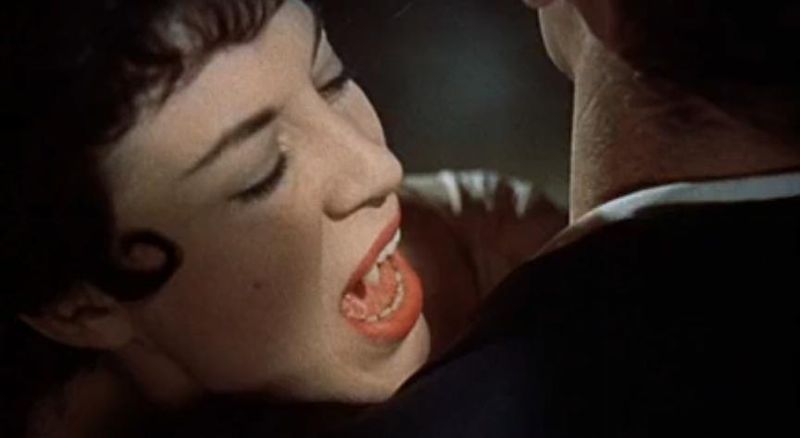



Above Van Eyseen with Christopher Lee as "Dracula" looks at a photograph of the other's fiancee. Not "Mina", but "Lucy".
"Jonathan" has come to the castle to be "Dracula's" new librarian and after the above scene with the Count. He finds himself wished a good night and locked in his bedroom. The real mission "Harker" is now on is as a "Vampire Hunter" sent by "Dr. Van Helsing". He goes to sleep and when he awakes "Jonathan" now discovers the bite marks and knows he is doomed to become a vampire and must finish his task of destroying "Dracula".

The door to his room is now open and he goes outside of the castle and hides his journal by a statue of the Virgin Mary.
"Harker" next enters the crypt were the girl and the Count are asleep in their coffins. He finds the girl and takes out a stake and hammers it into her heart. She returns to her actual age in death.


Now he approaches the casket containing "Count Dracula". However, the sun is down and the Count is not in it.
"Van Helsing" arrives at Castle Dracula and discovers "Jonathan's" Journal placed by the statue and enters the crypt. He goes to "Dracula's" coffin, but finds the vampire that "Harker" has becomes and drives a stake through its heart freeing his friend. "Van Helsing" leaves, not locating "Dracula", to give the news of "Jonathan's" death to the brother of "Harker's" fiancee "Arthur Holmwood".
A very sexy "Dracula" has been with "Lucy" and she has become his bride. It is up to "Van Helsing" to convince "Arthur" of this fact and for the two to give her peace.


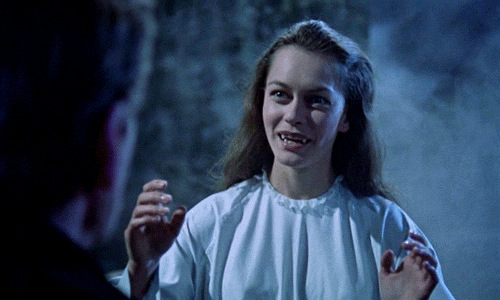
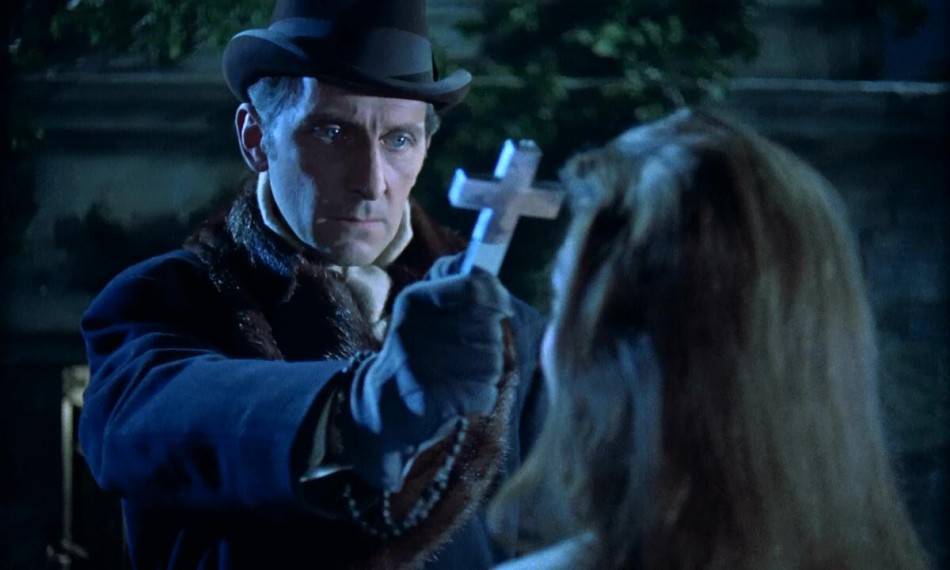


After driving a stake through his sister's heart. "Arthur" and "Van Helsing" start a search for the Count, but discover that he has visited "Mina". Where could he be hiding? The answer is discovered as the "Holmwood's" own basement, but "Dracula" escapes. "Van Helsing" decides he is heading for his Castle and the two men leave "Mina' to go there, but she receives a message to meet "Arthur". It is a trap made by "Dracula" who awaits her.
Knowing he's being pursued "Dracula" drives his carriage like a mad man to reach his castle before sunrise. He attempts to bury "Mina" alive in front of the Castle's entrance as "Van Helsing" and "Arthur" arrive. Rushing inside he is followed by "Dr. Van Helsing". As outside "Arthur" comforts his saved wife.
Inside is the first Technicolor destruction sequences of "Dracula". As "Van Helsing" fights with him and has to make a crucifix out of two candle sticks and pulls the curtains open to reveal the sun.

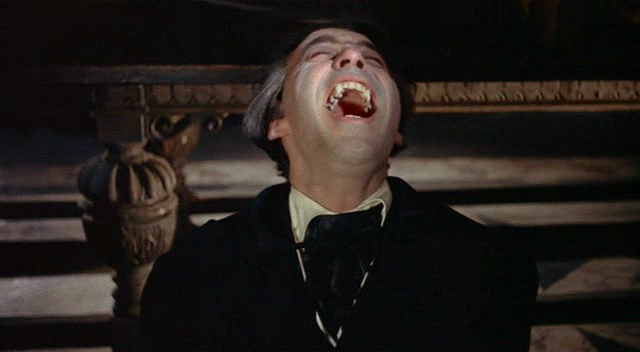

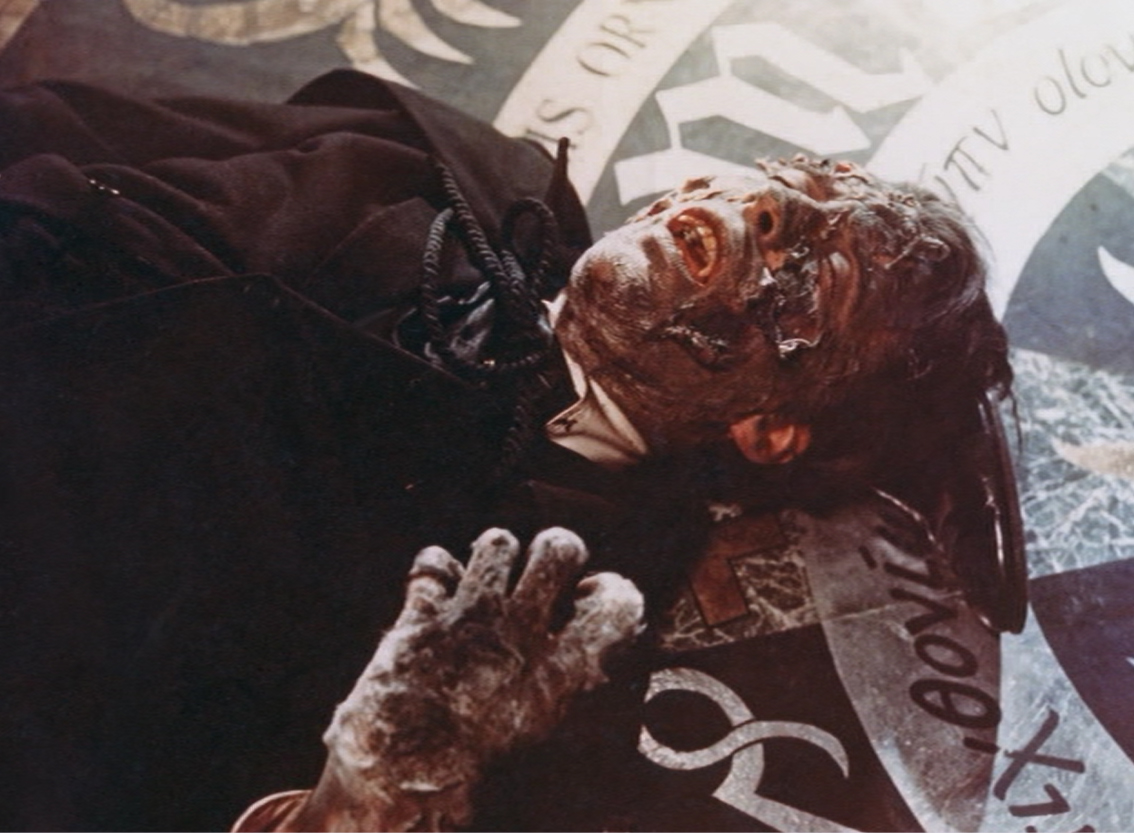


Finally nothing is left but dust blowing in the breeze.
Although Peter Cushing is back as "Dr. Van Helsing" in 1960's "The Brides of Dracula". Hammer left out the Count and replaced him with the "Baron Meinster". The fans told the studio what they felt about No "Dracula" and No Christopher Lee. They got the message, but not until 8 years after the original and in 1966 Lee was back as "Dracula: Prince of Darkness" still without Cushing except in the prologue.
The film starts with the death sequence from the 1958 movie and then a follower of the Count uses the blood of some tourists to bring "Dracula" back to life. This was a start of a series of "Dracula" films from Hammer with Lee and eventually Cushing would join him as two different members of the original "Van Helsing's" family.
The novel was a Thriller about a Family Curse featuring the World's First Consulting Detective. Hammer Films acquired the rights from Sir Arthur Conan Doyle's Estate and was about to turn it into a Gothic Horror Film in Technicolor.
THE HOUND OF THE BASKERVILLES released May 4, 1959

Terence Fisher was the director, but the screenplay was by Peter Bryan. For Hammer he was an unusual choice. Between 1947 and 1952 Bryan was a camera operator for 20 motion pictures. In 1953 he was a cinematographer for one short subject and then has no film work until 1957, but then as a screenplay writer. This is only Peter Bryan's second screenplay. Among his total of 10 are 1960's "The Brides of Dracula" with Jimmy Sangster. Then on his own are 1966's "Plague of the Zombies" and 1968's "The Blood Beast Terror".
Peter Cushing is "Sherlock Holmes". Cushing would portray "Holmes" in one of the many BBC series.
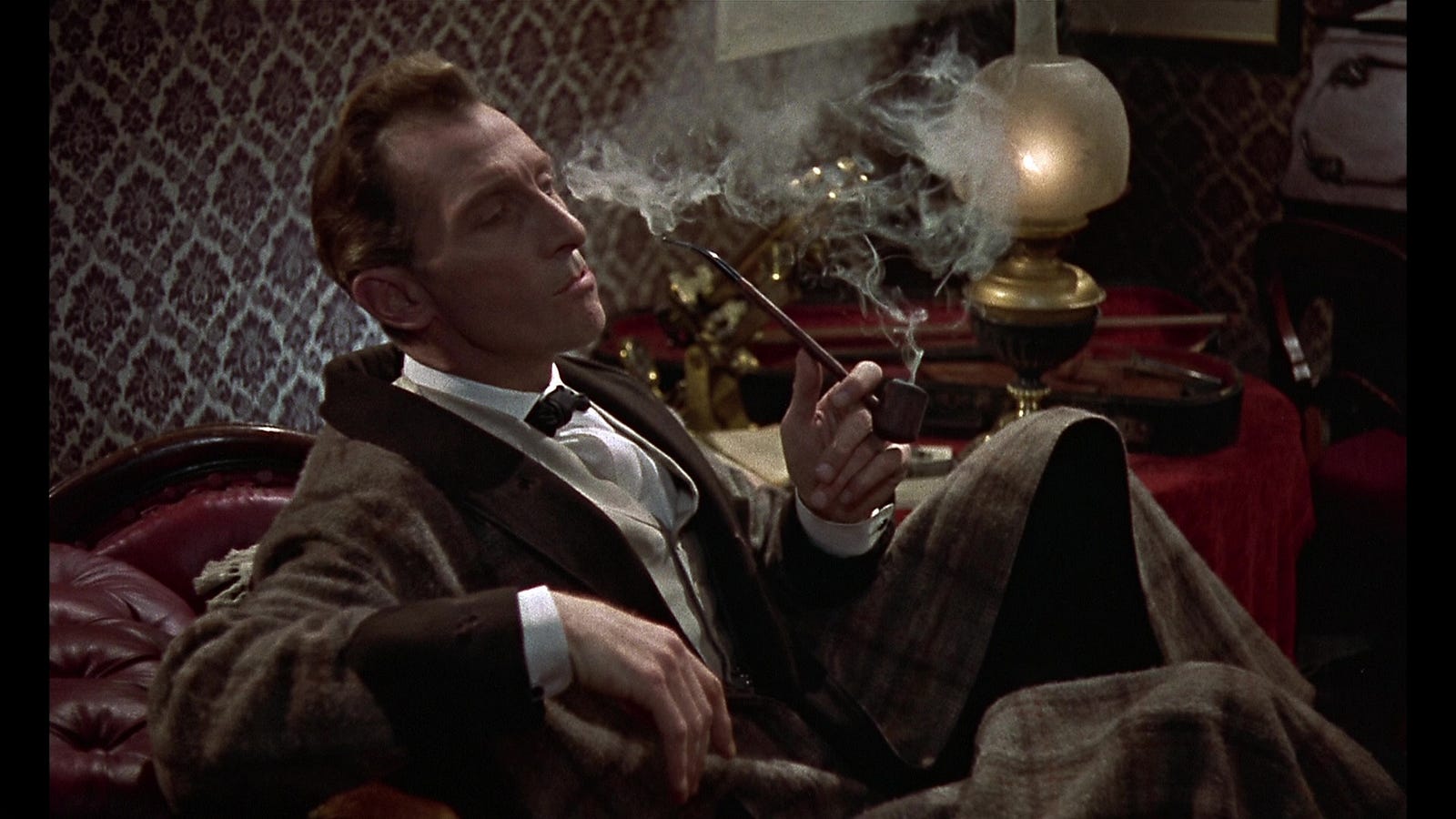
Christopher Lee was not "Dr. Watson", but "Sir Henry Baskerville". The heir to the "Baskerville Fortune and Estate". Lee would portray the consulting detective in a U.K.-West German picture, 1962's "Sherlock Holmes and the Deadly Necklace", from a screenplay by German-American writer Curt Siodmak. That film was shot in two versions. One in German with Lee speaking fluent German and the other in English. Between 1959 and 1970 Christopher Lee appeared in 12 Foreign Language films, made either in Italy, Spain, or Germany, speaking fluently the language of the country it was being made in. My article on these mostly unknown motion pictures can be read at:
http://www.bewaretheblog.com/2016/08/christopher-lee-foreign-language-motion.html
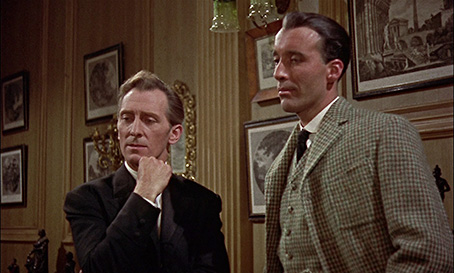
Andre Morell was "Dr. Watson". Morell had some interesting movies and television roles. Among them are "Colonel Green" in 1957's "The Bridge on the River Kwai", "Professor Bernard Quatermass" on the original 1958 BBC production of "Quatermass and the Pitt", and in 1959 "Behemoth the Sea Serpent" aka: "The Giant Behemoth" and "Ben Hur".
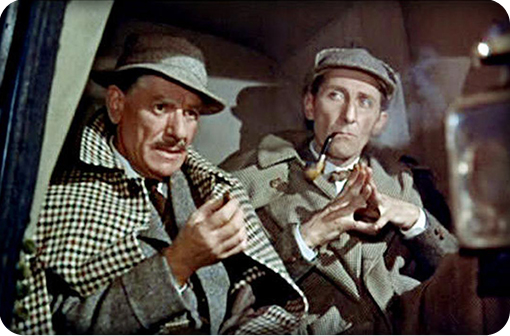
Being a Hammer film not only is the story more Gothic than any other version, but there's some great Technicolor blood. As in the opening with "Dr. Mortimer", Francis De Wolf, narrating the legend of the "Hound of Hell the Hound of the Baskervilles". When the telling of the legend is completed, with "Sir Hugo Baskerville", David Oakley's, death by the giant hound, we find "Dr. Mortimer" now speaking to "Sherlock Holmes" and "Dr. Watson".
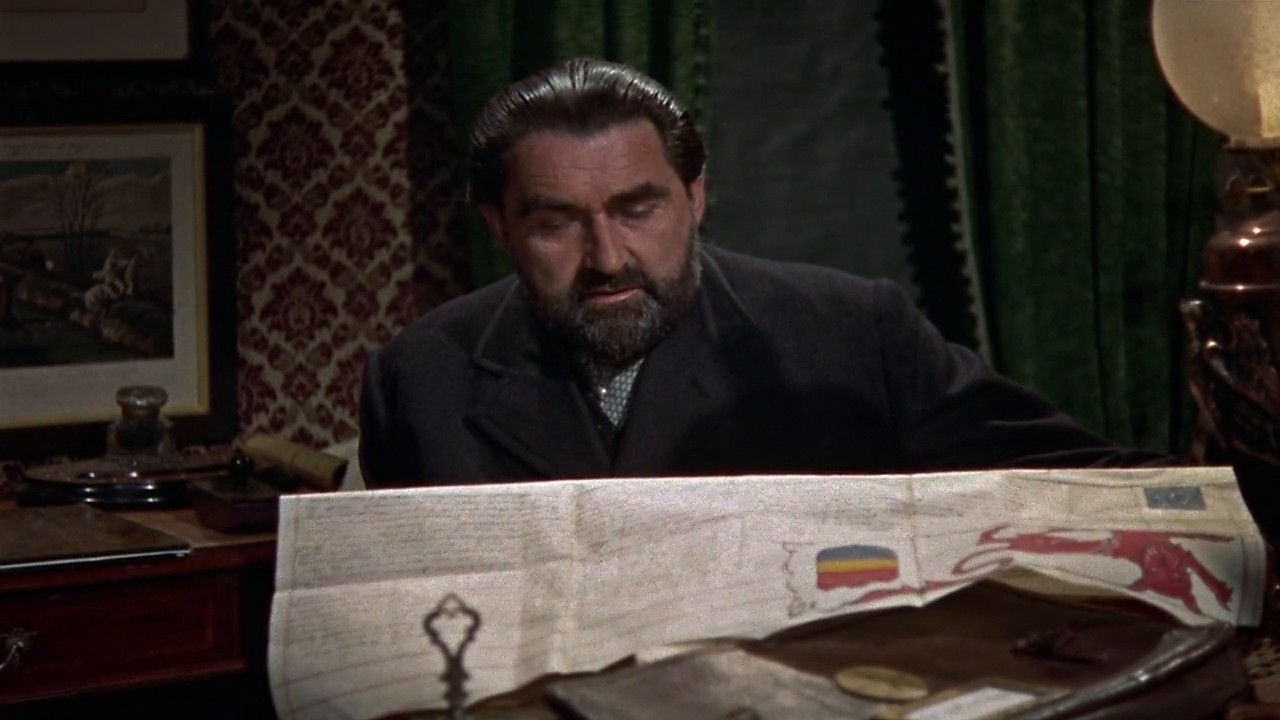
Above Francis De Wolf and below David Oaxley.
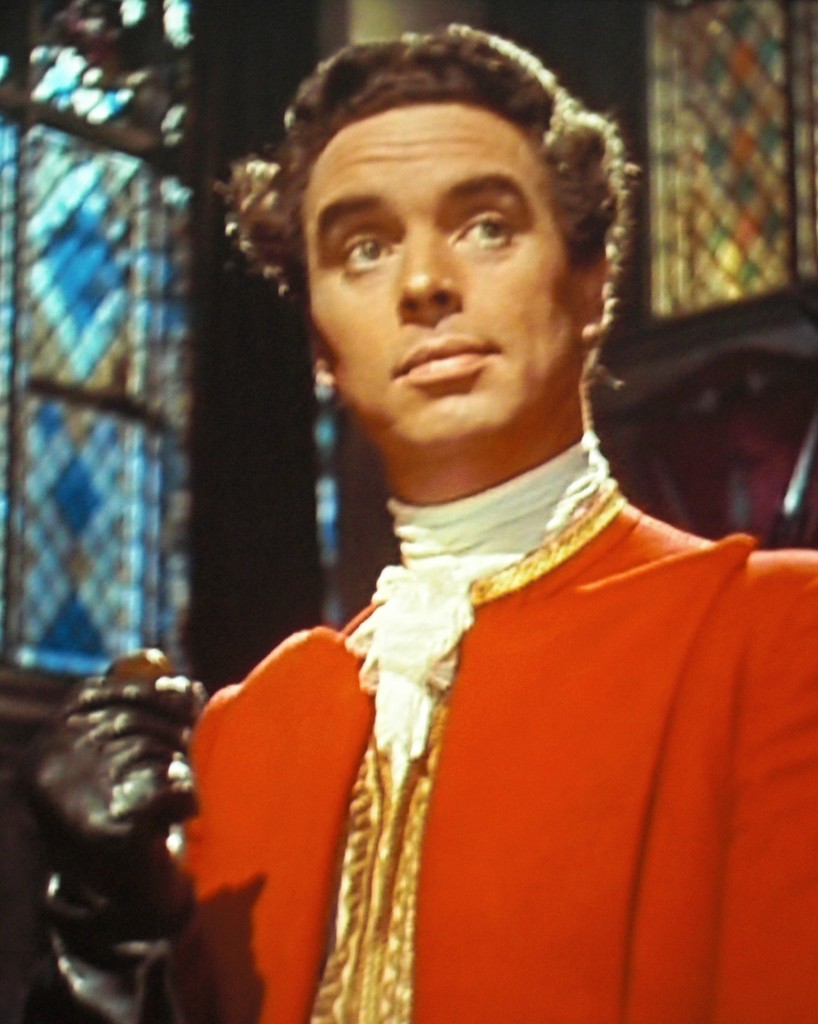
What Hammer's version of the novel does that other films didn't. Is not having the role of "Sir Hugo" and "Stapleton" portrayed by the same actor that can become a give-a-way to the ending. In this picture "Stapleton" is portrayed by Ewen Solon.
.jpg)
Some of the changes in Sir Arthur Conan Doyle's novel that add to Hammer's Gothic Horror version. Start by having "Sir Hugo" involved with ritual sacrifices bringing causing the appearance of the "Baskerville Hound".
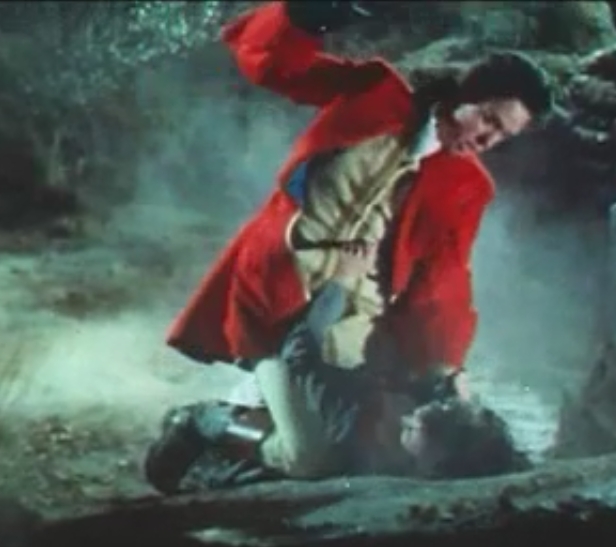
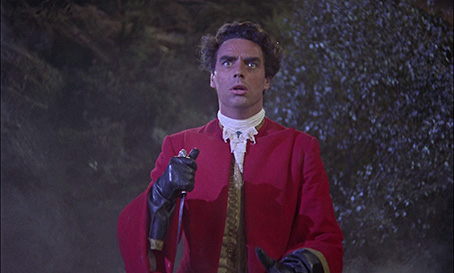
There is no tarantula almost killing "Sir Henry" in the novel, but it makes a great sequence.

In the movie the demonic hound wears a mask to make it more fearsome looking. In the novel he's a normal hound with phosphorus on his body.

In the end "Cecile Stapleton" is killed by falling into the Grimpen Mire. She does not die in the novel.

My article on all the motion picture versions of "The Hound of the Baskervilles" between 1914 through 2016 can be read at:
http://www.bewaretheblog.com/2017/12/sir-arthur-conan-doyles-hound-of_13.html
However, it was also in 1959 the Peter Cushing and Christopher Lee were teamed in a third Hammer reboot of a Universal Horror film. Although the end result was not the picture the studio wanted to make.
THE MUMMY released September 25, 1959

Director Terence Fisher and screenplay writer Jimmy Sangster along with the executives of Hammer Films. Specifically wanted to remake the 1932 "The Mummy" that had starred Boris Karloff as "Imhotep" aka: "Ardath Bey" and do it for the first time in Technicolor. However, that Universal Pictures screenplay was owned by writer Nina Wilcox Putnam, not the studio, and she was still alive. Wilcox Putnam had seen both Hammer's versions of "Frankenstein" and "Dracula" and hated them with all the Technicolor gore. She would not make a deal with Hammer.
To answer the unspoken question in 1999 Universal Pictures was able to make their new film "The Mummy" with the characters of "Imhotep" and the "Princess Anck Su Namun" simply because Nina Wilcox Putnam was dead and they now owned her 1932 screenplay free and clear. They did give her on screen credit for the original though.
Hammer films was forced to remake the series featuring "Kharis" and the "Princess Ananka". However, for one sequence only, Hammer was able to get around Nina Wilcox Putnam. In 1940's "The Mummy's Hand" there is a flashback sequence with "B" Cowboy Tom Tyler as "Kharis". In it the audience learns how the High Priest "Kharis" attempted to bring back his dead love the "Princess Ananka", but was caught and buried alive as a Mummy.
When the sequence was filmed by director Christy Cabanne in 1940. He used extensive footage of Boris Karloff as "Imhotep" committing the same crime for his love the "Princess Ankh-es-en-Amon" from the 1932 original. Wilcox Putnam could not call foul as the scene Hammer Pictures was basing their own screenplay was not from her 1932 originial, but Griffin Jay's 1940. There were other subtle "lifts" from the 1932 "The Mummy".
Peter Cushing was "John Banning". In 1940 Dick Foran had been "Steve Banning".
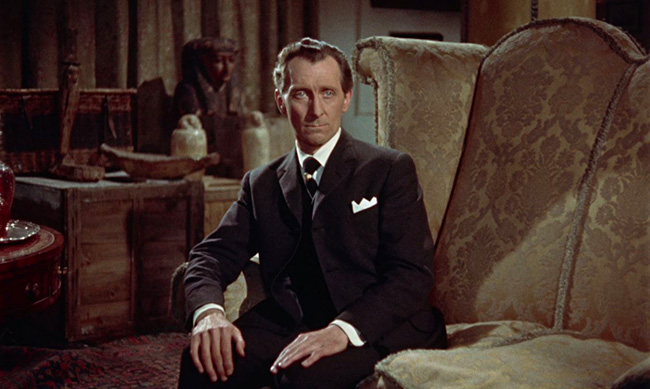
Christopher Lee was "Kharis". As I mentioned with played by Tom Tyler originally and then Lon Chaney, Jr. for three features.


Yvonne Furneaux was Cushing's wife "Isobel Banning" and Lee's love the "Princess Ananka". Among French actress Furneaux's work was 5th billing in Errol Flynn's 1953 version of Robert Lewis Stevenson's "The Master of Ballantre", she co-starred in the detective classic 1953's "The House of the Arrow" with Oscar Homolka, in 1955 Furneaux was back with Flynn in "The Warriors" and made several French films after that. The actress followed "The Mummy" as one of the stars of Italian director Federico Fellini's 1960 classic "La Dolce Vita" and co-starred in director Roman Polaski's 1965 classic "Repulsion".


Raymond Huntley was "Joseph Whemple" in the Hammer Film. In the 1932 Universal Picture the role of "Sir Joseph Whemple" was portrayed by Arthur Byron.

Huntley above and Byron below.

"Mehemet Bey" was portrayed by George Pastell. In Universal Pictures 1942 "The Mummy's Tomb". The character of "Mehemet Bey" was played by Turhan Bey.

Above George Pastell and below Turhan Bey.

Jimmy Sangster's screenplay took major elements from the already mentioned 1940 "The Mummy's Hand" and the setting concept from 1942's "The Mummy's Tomb". His story would be set partly in Egypt and partly in England. Instead of either entirely in Egypt as in 1940, or partly in Egypt and partly in Louisiana as in 1942. Next Sangster used the entire ending from 1944's "The Mummy's Ghost". The only picture not used was Universal's 1944's "The Mummy's Curse".
The year is 1895 and archaeologists "John Banning", his father "Stephen Banning", Felix Aylmer, and Uncle "Joseph Whemple" are part of a British expedition searching for the tomb of the "Princess Ananka". "John" has broken his leg and refused medical treatment to stay on site for the opening of the tomb. As a result his leg will not mend properly and he is confined to a tent.

Before "Stephen Banning" and "Joseph Whemple" can enter "Ananka's" tomb a strange Egyptian named "Mehemet Bey" arrives. He gives them the warning about the curse that will be upon those who disturb the resting place of the Princess. The two ignore "Mehemet Bey", break the seal on the tomb, and enter.


The two also discover the "Scroll of Life". Another lift from the original 1932 film were it is called the "Scroll of Thoth". While "Joseph" goes to tell "John" about the discoveries. "Stephen" has remained in the tomb and starts to read the scroll.
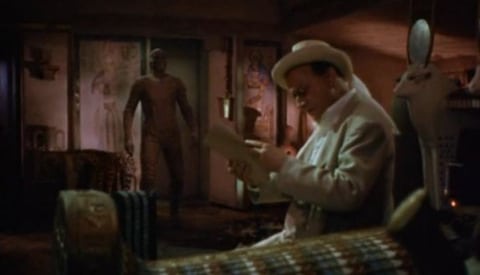
When "Joseph" returns the scroll is gone and "Stephen" is in a catatonic state. In 1932 Bramwell Fletcher as "Ralph Norton" goes insane after reading the "Scroll of Thoth" and Boris Karloff's "Mummy" takes it. Note that Christopher Lee's "Mummy" is seen moving toward "Stephen Banning" in the above photo after being accidentally brought back to life by "Banning's" reading of the scroll. Below Karloff 's "Mummy" reaches for the scroll as "Norton" looks on. Watch the movie and the scene completely cuts out Karloff in wrappings and tightened it by only showing his hand reaching for the scroll.
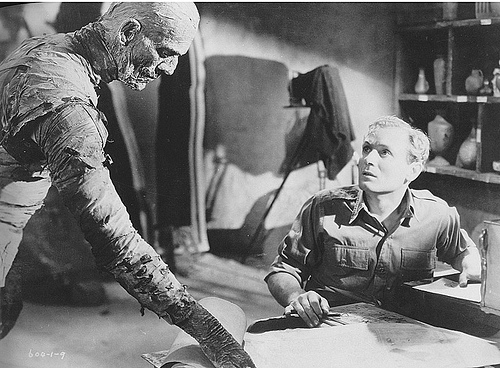
Back in England "Stephen Banning" is in a "Nursing Home for the Mentally Disordered". He comes out of his catatonic state and sends for "John". He tells his son that while reading the "Scroll of Life" he brought "Kharis" back from the dead.

"Stephen" tells "John" how "Kharis" the High Priest of Karnak loved the "Princess Ananka" and when she suddenly died. After leading her funeral procession. He attempted to bring her back to life, but was captured and sentenced to have his tongue cut out and buried alive.






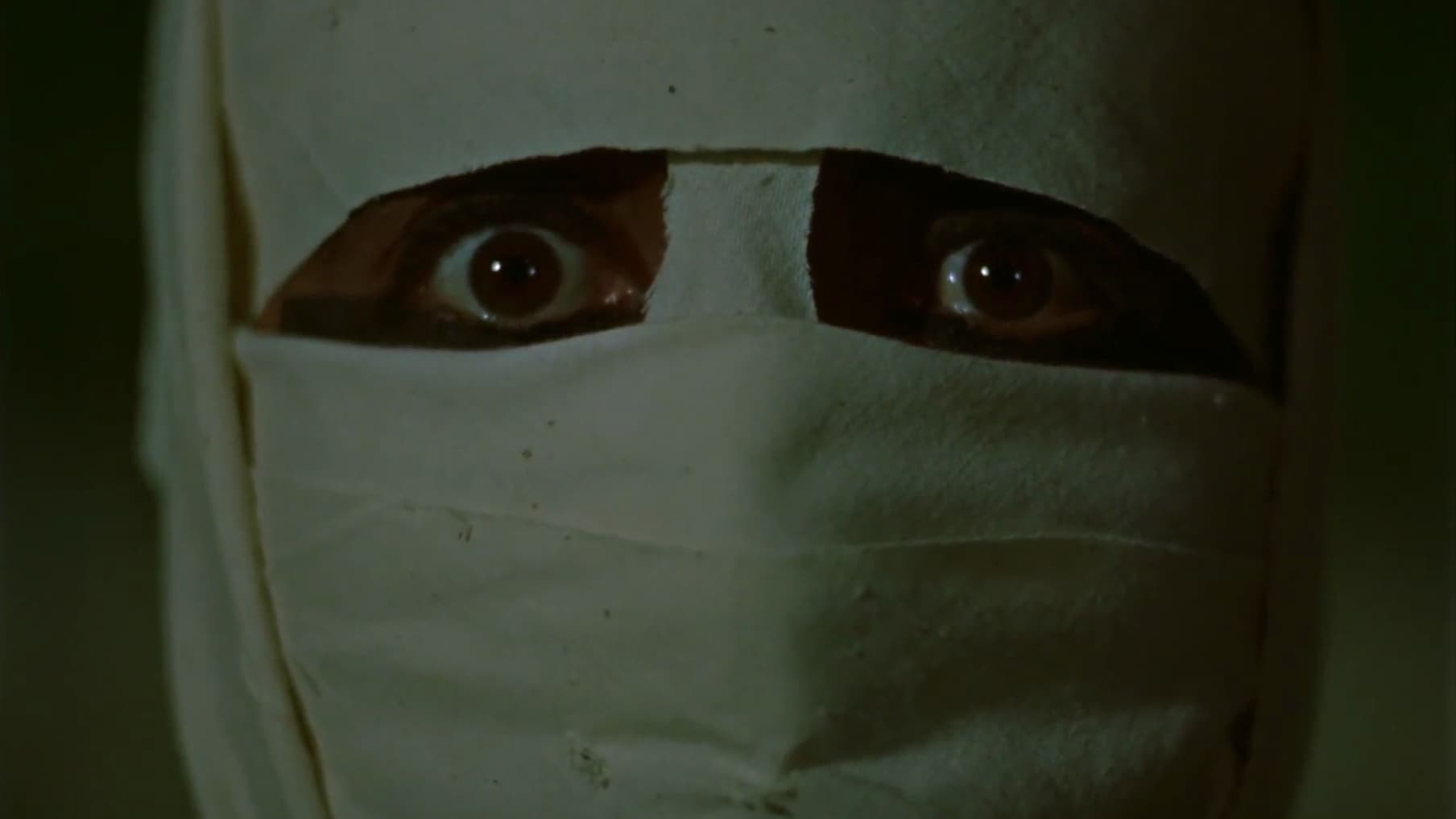

Father warns son that "Kharis" will come to kill the members of the expedition. "Mehemet Bey" and "Kharis" are in a home near "John Banning's" residence and "Kharis" is sent first to kill "Stephen Banning".

The following night "Kharis" is once again sent out and this time to kill "Joseph Whemple". "John" is there and witnesses the Mummy's attack and murder of "Whemple".
Inspector "Mulrooney", Eddie Byrne, has been sent to solve the murders and doesn't believe "John Banning's" story of a killer Mummy. Even after "Banning" states he's to be number three. While "Mulrooney" gathers testimony for locals that is starting to make him believe "John's" strange tale. "Banning" is attacked by "Kharis".


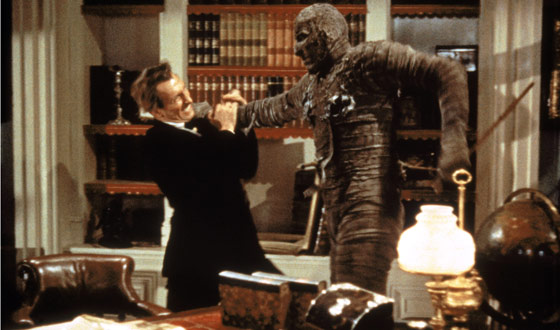
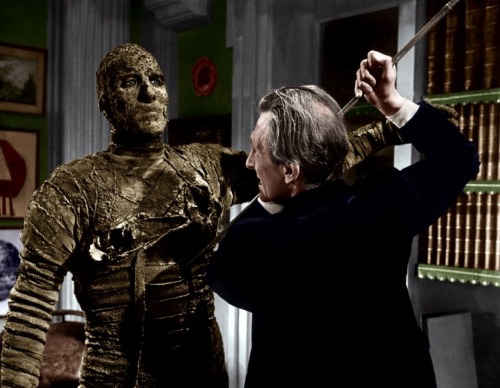
Suddenly "Kharis" stops his attack and is staring in a different direction. Turning "John" sees his wife and just as suddenly "Kharis" leaves.

The reaction of "Kharis" to "Isobel Banning" sets "John" thinking and he finally realizes his wife looks exactly like the "Princess Ananka". A trap is set by "Mulrooney", but "Kharis" not only escapes. He takes "Isobel" and heads for the swamp area near her home. "Mehemet Bey" orders "Kharis" to kill "Isobel Banning", but the Mummy believes she is his love "Princess Ananka" Instead the Mummy kills "Mehemet Bey". Meanwhile, "Mulrooney' has gotten the villagers armed with shotguns and rifles to come with him in search of "Mrs. Banning".



At the climax "Isobel" is rescued by "John" and "Kharis" is blown to bits.
It would be another 5 years before the two actors so associated with Hammer Horror would make another film together for the studio.
THE GORGON released August 21, 1964

For the American release somebody in Columbia Studio's publicity department thought they were being cute with the tag line:
She Had A Face Only A Mummy Could Love!Once again the picture was directed by Terence Fisher, but the screenplay was by John Gilling. Gilling was a writer and director of "B" British films since 1947. His second writing assignment, if you can find it, was 1948's "The Greed of William Hart" that arrived in the United States in 1953 as "Horror Manics". The picture is worth a look. It starred early British Horror Icon Tod Slaughter. In 1936 he portrayed "Sweeney Todd" in "The Demon Barber of Fleet Street". In 1956 John Gilling wrote the screenplay for the forgotten U.K. Science Fiction "The Gamma People", in 1961 he wrote, produced and directed "Fury at Smuggler's Bay" starring Peter Cushing and in 1962 he directed Hammer's "The Pirates of Blood River" starring Christopher Lee.
Peter Cushing was "Dr. Namaroff".

Christopher Lee was "Professor Karl Meister".

Barbara Shelley was "Carla Hoffman". Among her pictures is the original 1960 "Village of the Damned", 1966's "Dracula: Prince of Darkness" and 1967's "Quatermass and the Pit" aka: "Five Million Years to Earth". My article on the actress may be read at:
http://www.bewaretheblog.com/2019/06/barbara-shelley-hammer-pictures-horror.html

Patrick Troughton was "Inspector Kanof". Troughton was the Second "Dr. Who", "Phineas" in Ray Harryhausen's 1963 "Jason and the Argonauts" and "Klove" in 1970's "Scars of Dracula".

Above Patrick Troughton listens closely to Peter Cushing's answers to his questions.
Somebody is turning the people in the 1910 German town of Vandorf to stone.

We are dealing with a "Gorgon" and not the ever popular "Medusa", but her sister "Megaera". As there is only one major female character in the screenplay. It is easy to figure out who it is, but the fun is watching these pro's interact with each other. This may not be in the same class as the previous films I've mentioned, but your time is not wasted on a very atmospheric Hammer entry.






One year later the House of Hammer turned to a piece of classic British adventure literature by H. Rider Haggard the author of "King Solomon's Mines".
SHE released April 18, 1965
I saw the picture two months later when it opened on June 9, 1965 in the United States.

The film was directed by Robert Day. In 1958 he directed the very good and overlooked "The Grip of the Strangler", known in the United States as "The Haunted Strangler", starring Boris Karloff. The same year he directed another Horror entry with Boris Karloff "Corridors of Blood" co-starring Christopher Lee. Next it was the cult Science Fiction film: 1959's "First Man in Space" followed by two "Tarzan" features leading to this picture.
The screenplay was David T. Chantler. Chantler started out as a writer for television's "The Adventures of Superman" and "Richard Diamond, Private Detective". His first screenplay wasn't until 1962's "Cash on Demand" a crime drama starring Peter Cushing and Andre Morell. He followed that film with 1963's "Follow the Boys" starring singer Connie Francis, Paula Prentiss, Russ Tamblyn and Richard Long.
Ursula Andress was "Ayesha". When she portrayed "Honey Ryder" in the first "James Bond" film 1962's "Dr. No". Her Swiss accent was considered too heavy to understand and her voice was dubbed by voice actress Nikki van der Zyl. This production did the same thing. The actress had two films that came between "Dr. No" and "She". These were 1963's "Fun in Acapulco" starring Elvis Presley and the same years Frank Sinatra and Dean Martin comedy Western "Four For Texas". Both had no problem using her real voice.
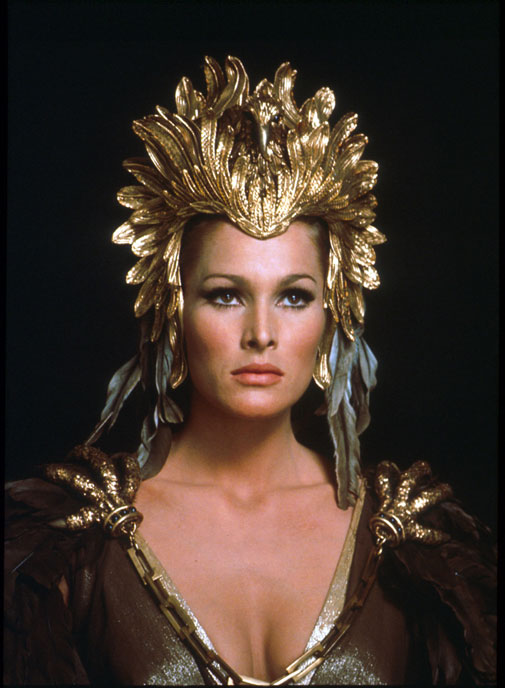
Peter Cushing was "Holly".

Bernard Gribbins was "Job". To fans of David Tennant's 10th "Dr. Who" Gribbins was "Wilfred Mott" "Dr. Donna's" father. The character actor was seen on British television in such major programs as "Coronation Street", "Faulty Towers" and the children's series "The Wombles".
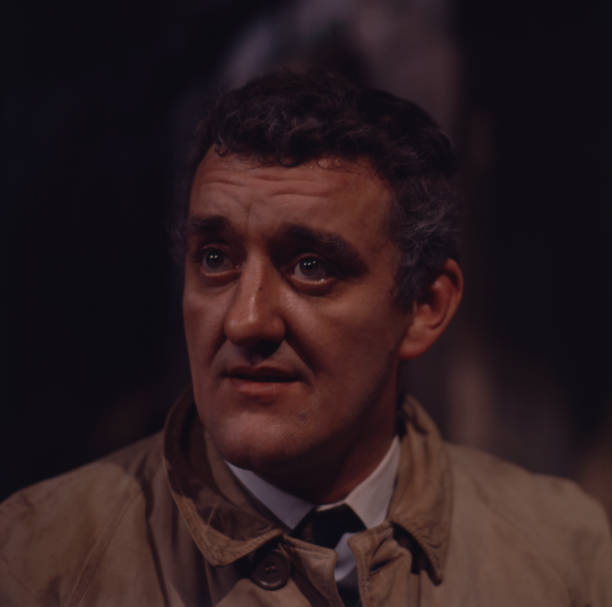
John Richardson was "Leo". In 1960 Richardson co-starred with Barbara Steele in Italian director Mario Bava's "Black Sunday", he was "Tumak" in Ray Harryhausen's 1966 "One Million Years B.C." and was in the Italian Science Fiction "War of the Planets".

Rosenda Monteros was Ustane. Monteros was mainly a Mexican film actress, but played the girl "Petra" in the original 1960 "The Magnificent Seven".

Christopher Lee was "Billiali".
Andre Morell was "Haumeid".

Three friends "Holly", "Job" and "Leo" have just been honorably discharged from the British Army in 1918 Palestine. What they next are going to do is being discussed as a mysterious young women named "Ustane" approaches "Leo" with an equally mysterious map.

That night "Leo" thinks he's dreaming, but meets a beautiful women who speaks of the map and the Lost City of Kuma. The three friends locate "Ustane" and she agrees to lead them to the city she had left. On the trip "Leo" becomes very ill with a fever and "Ustane" falls in love with him. Once within the walls of Kuma they are attacked by the Amahagger the slaves of "Ayesha":
SHE WHO MUST BE OBEYEDThe overseer of the Amahagger arrives and attempts to stop the cannibalistic slaves from eating the three Englishmen. This man is also "Ustane's" father "Haumeid", but he can't control them. Suddenly a female voice speaks out and everything just stops. It is "Ayesha" and when she sees "Leo". She almost faints as he is the reincarnation of her lost love "Kallikrates". "Ustane" asks to nurse "Leo" back to health and the Queen agrees.
After "Leo" recovers "Ayesha" shows the three adventurers the remains of this original Roman and Egyptian city.
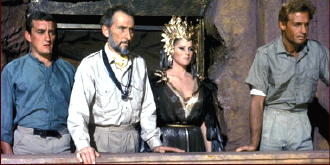

As the story enfolds the audience discovers that "Ayesha" is immortal and has lived for 2,000 years. There is a secret of her eternal life and she wants "Leo" to share it. However. the High Priest "Billali" wants to become immortal and until "Leo" appeared thought he would be able to convince "Ayesha"
At the film's climax "Ayesha" executes "Ustane" in a fit of jealousy. A revolt of the Amahaggar led by "Haumeid" takes place. As the Queen takes "Leo" to the secret cave containing the flames of immortality. "Billali" attempts to kill "Leo", but is killed himself. As "Holly" and "Job" arrive they watch as "Ayesha" takes "Leo" into what is now a cool blue flame.

What "Ayesha" didn't expect was going a second time into the eternal flame reverses her immortality, she ages 2,000 years, and turns to dust. In a switch on H.Rider Haggard's novel "Leo" is now immortal and bids his friends "Holly" and "Job" farewell as he remains now the ruler of Kuma.

I would be another 7 years before Peter Cushing and Christopher Lee would appear together in a Hammer Film's production. They had been seen in several Horror films from another British film company Amicus Productions such as 1965's "Dr. Terror's House of Horrors" and 1970's "Scream and Scream Again" with Vincent Price, but nothing for the "House of Hammer". Now in a modern setting they were once again "Dracula" and his pursuer "Dr. Van Helsing".
DRACULA A.D. 1972 released September 28, 1972
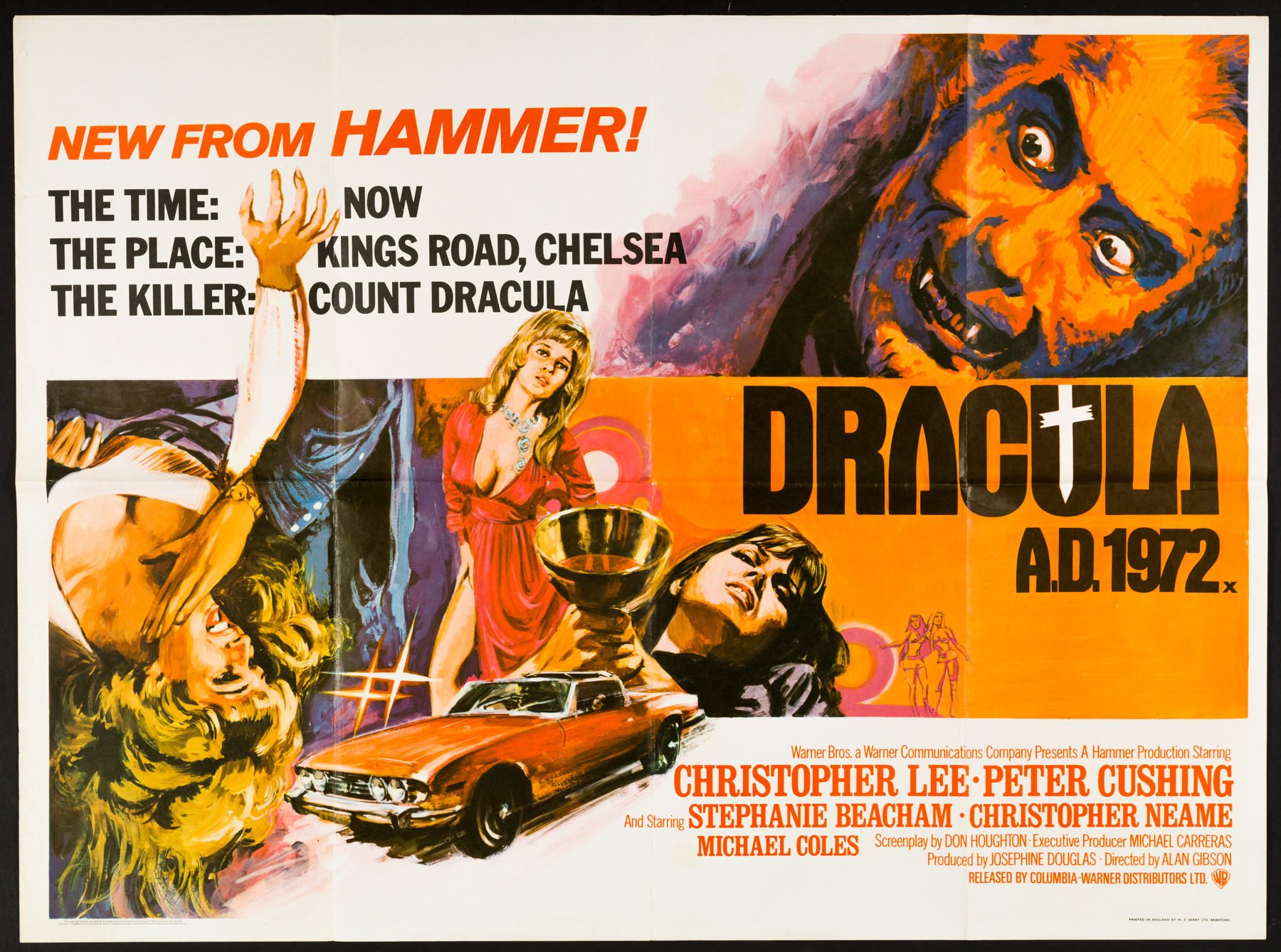
British television director Alan Gibson was assigned this motion picture. Prior to this motion picture Gibson had worked on 16 television programs and just two forgotten 1970 Horror movies. "Crescendo" starring American's Stephanie Powers and James Olson and "Goodbye Gemini" starring Judy Gleeson and Sir Michael Redgrave.
The screenplay was by Don Houghton. Houghton was a British television writer who wrote two adventures for Jon Pertwee as the 3rd "Dr. Who". He only has two other motion picture screenplays the follow up to this picture and 1974's "The Legend of the 7 Golden Vampires". That non-Christopher Lee film starred Peter Cushing as "Professor Lawrence Van Helsing" and featured John Forbes-Robertson as "Dracula".
Christopher Lee was "Dracula"

Peter Cushing was both "Lorrimer Van Helsing" and "Lawrence Van Helsing".

Stephanie Beacham was "Jessica Van Helsing". Beacham was a British television actress and this was her third feature film. The first two were also Horror pictures and she followed this film with 1973's "Now the Screaming Starts" featuring Peter Cushing and Herbert Lom.

Christoper Neame was "Johnny Alucard". Anyone familiar with Lon Chaney, Jr.'s 1943 "Son of Dracula" immediately knows that "Alucard" is "Dracula" spelled backwards. This was Neame's 7th feature film and his third had beem 1971's "Lust of the Vampire". The second film of the "Karnstein" Trilogy from Hammer featuring Peter Cushing and based on Sheridan Le Fanus's 1872 Lesbian vampire story "Carmilla".
The tale by Le Fanus's predates Bram Stoker's "Dracula". It is the opening part of my article on not the usual Vampire motion picture stories. It can be read at:
http://www.bewaretheblog.com/2017/10/not-same-old-vampire-movies-or-get-your.html
Caroline Munro was "Laura Bellows". Munro was unknown at the time, but had appeared without on screen credit as Vincent Price's wife in 1971's "The Abominable Dr. Phibes" and in 1972's "Dr. Phibes Rises Again". After this film she co-starred in Ray Harryhausen's 1973 "The Golden Voyage of Sinbad", 1974's "Captain Kronos: Vampire Hunter" and 1976's "At the Earth's Core" with Peter Cushing and Doug McClure.

In 1970 American International Pictures released "Count Yorga, Vampire" about a modern day vampire. The film was so successful that it was followed by 1971's "The Return of Count Yorga". Warner Brothers wanted in on the action and they commissioned two modern day vampire movies from Hammer Studios that brought back the actual character of "Dracula".
Just prior to the release of "Dracula A.D. 1972" American International Pictures beat Warner Brothers out. AIP released another modern day vampire picture targeted at African-American audiences, but it became a cultural cross over box office hit. "Blackula" starred Shakespearean actor William Marshall and Denise Nichols.
The plot of "Dracula A.D. 1972" opens with a prologue set in 1872 as "Count Dracula" and his nemesis "Lawrence Van Helsing" are fighting on top of a horse drawn coach. The coach overturns impaling the Count on one of the wheels. "Van Helsing" is mortally wounded, but manages to push the broken wooden wheel into "Dracula's" heart destroying him. One of the Count's followers, played by Christopher Neame, collects the remains of "Dracula" and buries them next to the grave of "Van Helsing".
It should be remembered that Hammer's version of Bram Stoker's "Dracula" was set in 1885. Thereby, making this film predate it by 13 years and not related in any way.
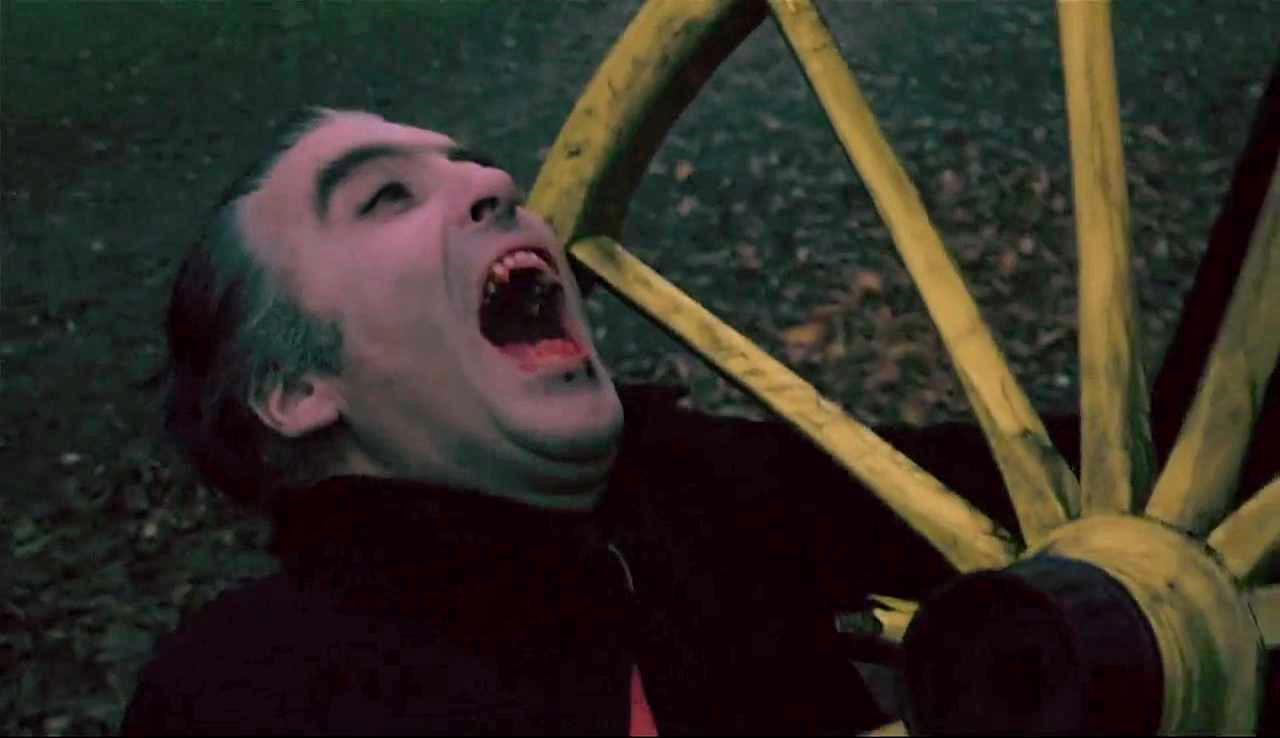

End of prologue and the film switches to 1972 Chelsea in London.
We now have a group of British Hippies that includes "Jessica Van Helsing" the granddaughter of "Lorrimer Van Helsing" and one "Johnny Alucard". "Johnny" talks the group into attending a black magic ceremony in the abandoned St. Bartolph's church. The group are shocked as he performs a very bloody ritual on one of the groups girl's "Laura Bellows".



"Jessica" and the others flee and continuing the ritual "Johnny" resurrects "Dracula". Who feeds off of "Laura". The next day "Laura's" body is discovered drained of blood and a police investigation begins. The investigation is led by "Inspector Murray" portrayed by Michael Coles.

"Johnny" brings another of "Jessica's" friends "Gaynor Keating", Marsha Hunt, to the church to feed the Count and at his own request. "Count Dracula" turns "Johnny Alucard" into a Vampire. "Lorrimer Van Helsing" now believes "Dracula" has returned.
Meanwhile, "Alucard" lures another of the group, "Bob", "Jessica's" boyfriend, to a cafe and turns him into a vampire. Then he has "Bob" go to "Van Helsing's" home knowing he is out and "Jessica" is alone. The two capture her and take the girl to "Count Dracula".

Aided by one of "Jessica's" other friends "Lorrimer" tracks "Alucard" to his flat and battles him. During the fight the two enter the bathroom and the shower comes up. "Johnny Alucard" is destroyed by his own shower's clear running water. Next "Van Helsing" goes to the church and discovers "Bob's" badly burned body. As apparently the vampire couldn't get to his resting place before the sun came up. He also finds "Jessica" in a trance, but otherwise unharmed.
"Van Helsing" now prepares a pit of wooden stakes in the graveyard and awaits nightfall and the return of "Dracula". There will be a battle, "Van Helsing" will throw holy water at "Dracula" burning his hands and the count will fall backwards into the pit. The stakes are not completely threw him so "Lorrimer" pushes the Count, with a shovel, further onto them and he is destroyed. "Jessica" is freed of the control of "Count Dracula".
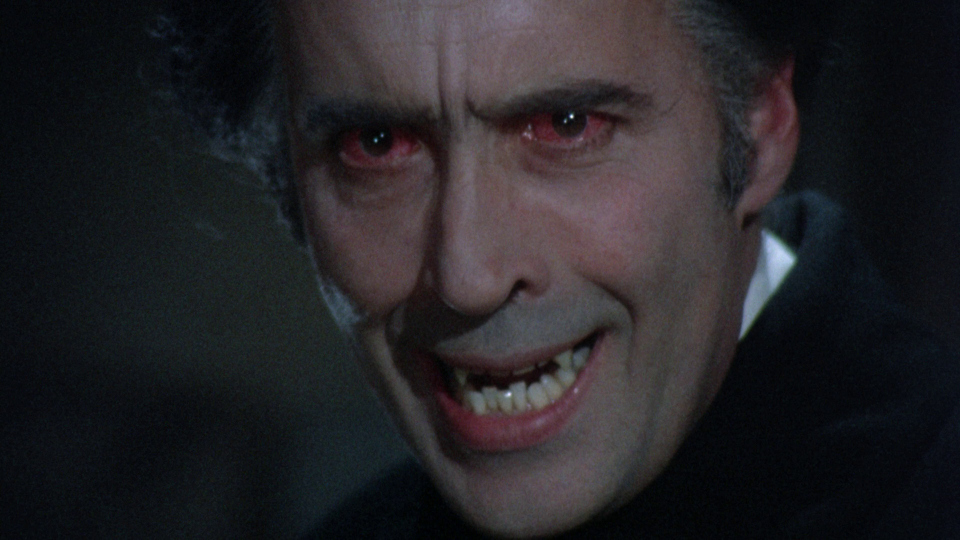
Although both actors careers would continue and both would intersect at times. The following was their last Hammer Film together.
THE SATANIC RITES OF DRACULA released November 3, 1973

Alan Gibson was back as director and the screenplay was once again by Don Houghton.
Christopher Lee, for the last time for Hammer Films, was "Count Dracula".
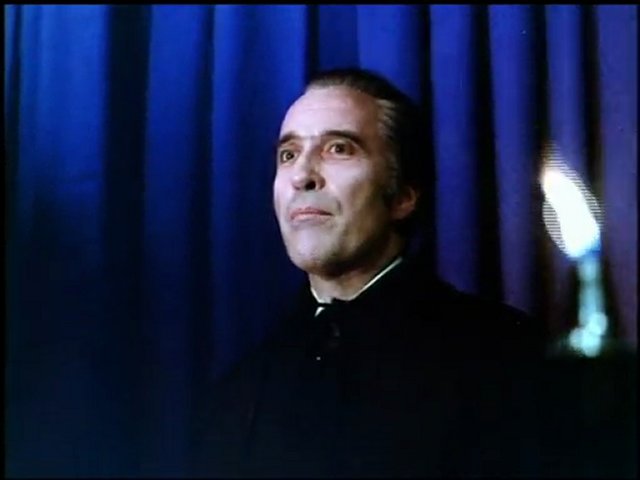
Peter Cushing was back as "Lorrimer Van Helsing".

Joanna Lumley was now "Jessica Van Helsing". Lumley is basically a British television actress, but she provided the voice for "Madeline Everglot" in Tim Burton's 2005 "The Corpse Bride", was "Aunt Emma" in Leonardo DiCaprio's 2013 "The Wolf of Wall Street" and appeared in both 1982's "Trail of the Pink Panther" and 1983's "Curse of the Pink Panther".

Where "Dracula A.D. 1972" had a "Prologue". This screenplay has an "Introduction", a middle section referred too as "In the House" and a "Denouement".
Introduction
In 1974 a Secret Service Agent escapes a house in the countryside and makes it back to MI-6. Before he dies the agent reveals that Satanic Rites are conducted there and that a prominent government minister, a peer, a general and a famous scientist are involved. He had a camera with him and the film reveals the four men on separate photos plus one of an empty doorway.. The leader of this cult appears to be "Chin Yang" played by Barbara Yu Ling.
Scotland Yard is called and "Inspector Murray", Michael Coles, is brought in on the case. He decides to call occult scientist "Lorrimer Van Helsing".
In the House

The cult kidnaps the Secretary of the Secret Service named "Jane" played by Valerie Van Ost, She will be bitten by "Count Dracula".
This is followed by Scotland Yard Inspector "Murray", Secret Service Agent "Torrrence", played by William Franklyn, and "Jessica Van Helsing" arriving at "The House". The group separates as they enter and "Jessica' finds "Jane", now a vampire, and other female vampires. They attack her, but "Murray" and "Torrence" rescue "Jessica" and put a stake through "Jane's" heart. The three escape the house and its grounds.

"Lorrimer Van Helsing" visits biological warfare scientist "Julian Keeley" played by Freddie Jones. He was one of those seen in the original agent's photographs. The mentally unstable "Keeley" is developing a special strain of the bubonic plague to be used by "Chin Jang's" cult. A guard shoots "Van Helsing" and when he awakes he finds the dead body of "Keeley" hanging from the ceiling and the plague flasks gone.
"Van Helsing" figures, from what "Keeley" told him, that an attack will be on the 23rd of the current month with the plague. The vampire hunter discovers that the date is actually the "Sabbath of the Dead". "Julian Keeley's" notes lead him to real estate developer "D.D. Denham" who funded the plague research.
"Denham's" headquarters turns out to be built on what was once the church in "Dracula A.D. 1972". "Van Helsing" after deduces that "Dracula" was in the photograph of the seemingly empty doorway. When he meets "Denham" he is actually "Dracula". "Van Helsing" attempts to kill "Dracula" with a silver bullet, but is stopped by the Count's co-conspirators. "Dracula" decides killing "Van Helsing" would be too simple and instead takes him to the house.
"Jessica", "Murray" and "Torrence" are still watching the House at a distance. They have been joined by the head of the Secret Service "Colonel Matthews" played by Richard Vernon. The watchers are attacked by snipers and "Torrence" and "Matthews" are killed. While "Jessica" and "Murray" are captured and taken into the house.
"Murray" awakes alone in the cellar and sees "Chin Yang" who is also a vampire. He confronts her and in the end drives a stake through her heart.

There are other vampires present and "Murray" is able to destroy them with clear running water from the sprinkler system in the house.
Denouement
"Dracula" arrives at the house with "Van Helsing". He announces to the other conspirators that with "Van Helsing" they will be his "Four Horsemen" carrying the bubonic plague to the world. While the world dies "Jessica Van Helsing" will have become his consort to rule at his side.
The conspirators realize what "Dracula's" plan means and refuse to help him. He regains control of the men through hypnosis. He commands the government minister to break the plague vile and he becomes infected.
"Murray" gets in to the computer control room and while fighting a guard part of the control panel is damaged starting a fire. The government minister is burnt to death and the plague virus destroyed as the house burns down.

"Murray" and "Jessica" escape and "Lorrimer Van Helsing" goes after "Dracula". Outside the Count is caught in a hawthorn bush and "Van Helsing" finds a wood stake and kills him as "Dracula" turns into ash.

This was not the best Hammer entry to end the teaming of Christopher Lee and Peter Cushing and Lee hated the film. As I said Ammicus Productions and other small British film makers teamed the two in films, but the two will always be Hammer's "Dr. Frankenstein" and "Count Dracula" to their many fans.
.jpg)


No comments:
Post a Comment